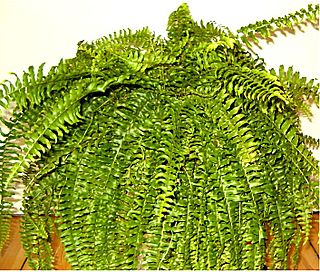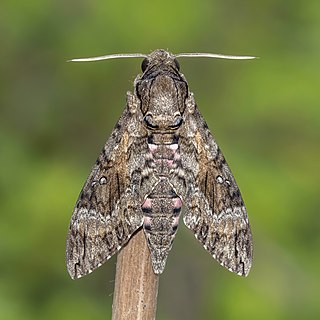
Nephrolepis is a genus of about 30 species of ferns. It is the only genus in the family Nephrolepidaceae, placed in the suborder Aspleniineae of the order Polypodiales in the Pteridophyte Phylogeny Group classification of 2016. The genus is commonly referred to as macho ferns or Boston ferns. The fronds are long and narrow, and once-pinnate, in the case of one Bornean species reaching thirty feet in length.

Agrius cingulata, the pink-spotted hawkmoth or sweetpotato hornworm, is a moth in the family Sphingidae. The species was first described by Johan Christian Fabricius in 1775.

Acherontia atropos, the Africandeath's-head hawkmoth, is the most widely recognized of three species within the genus Acherontia. It is most commonly identified by the vaguely skull-shaped pattern adorning the thorax, the characteristic from which its common and scientific names are derived. The species was first given its scientific name by Carl Linnaeus in his 1758 10th edition of Systema Naturae.
Prototheora is a genus of moths. It is the only genus of the Prototheoridae, or the African primitive ghost moths, a family of insects in the lepidopteran order, contained in the superfamily Hepialoidea. These moths are endemic to Southern Africa.

The Cape serotine is a species of vesper bat occurring in Sub-Saharan Africa. 'Serotine' is from Latin 'serotinus' meaning ‘of the evening'.

Callopistria maillardi is a moth of the family Noctuidae. The species can be found throughout central, eastern and southern Africa, including the islands of the Indian Ocean, Yemen, Chagos islands, Pakistan, India, Sri Lanka, southern China, in Hawaii, Hong Kong, New Zealand, the Society Islands, Sulawesi, as well as Queensland in Australia.

Sphenarches anisodactylus, commonly known as the geranium plume moth, is a species of moth in the family Pterophoridae. It is found in western Africa, Madagascar, India, Sri Lanka, Thailand, Japan, the New Hebrides and Central and South America, as well as Australia, where it has been recorded from Cape York to central New South Wales. It is found in the United States, where it has been recorded from Florida, as well as Mississippi. It is also present in the Kermadec Islands of New Zealand.
The Micronoctuini are a tribe of moths in the family Erebidae that includes about 400 described species. Typical species in the tribe have bifine hindwing venation and are smaller than those in other noctuoid moths. Micronoctua karsholti is the smallest of all species in the superfamily Noctuoidea.
Prototheora parachlora is a species of moth of the family Prototheoridae. It is found in South Africa, where it is only known from the Karkloof Forest region of KwaZulu-Natal.
Prototheora corvifera is a species of moth of the family Prototheoridae. It is found in South Africa, where it is known only from the top of Table Mountain.
Prototheora monoglossa is a species of moth of the family Prototheoridae. It is found in South Africa.
Prototheora petrosema is a moth species of the family Prototheoridae. It is found in Western Cape and Eastern Cape provinces of South Africa. It lives in the predominantly fynbos cape vegetation of the temperate Knysna Forest. It has been found frequently around the lower slopes of Table Mountain in Cape Town.
Prototheora serruligera is a species of moth of the family Prototheoridae. It is found in South Africa.
Prototheora quadricornis is a species of moth of the family Prototheoridae. It is found in South Africa.
Prototheora cooperi is a species of moth of the family Prototheoridae. It is found in South Africa, where it has been found at three widespread locations in Cape Province, all characterized largely by fynbos vegetation within the Capensis region. It was found most commonly at a rather xeric site north of Oudtshoorn in the Swartberg mountains.
Prototheora geniculata is a species of moth of the family Prototheoridae. It is found in South Africa, where it known only from the Schoemanspoort in the Cape Province, which is located in a southern extension of the Karoo desert, generally referred to as the Little Karoo.
Prototheora drackensbergae is a species of moth of the family Prototheoridae. It is found in South Africa, where it is known only from the type locality east of the Drakensberg escarpment in KwaZulu-Natal.
Prototheora angolae is a species of moth of the family Prototheoridae. It is found in Angola, where it known only from the type locality which is located in central Angola.
Prototheora malawiensis is a species of moth of the family Prototheoridae. It is found in Malawi.
Paraptila biserrata is a species of moth of the family Tortricidae. It is found in Costa Rica.





